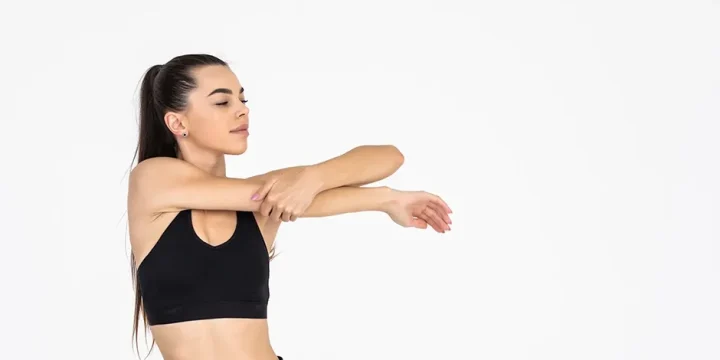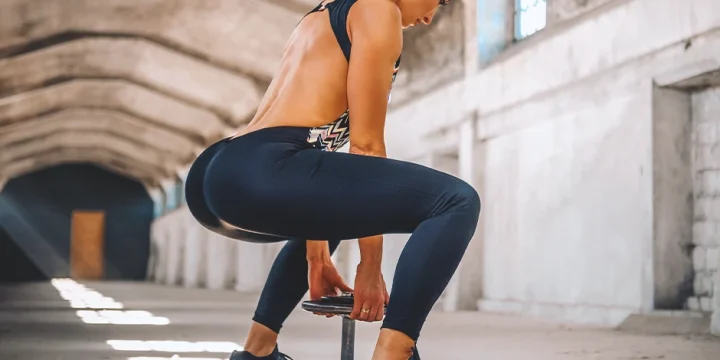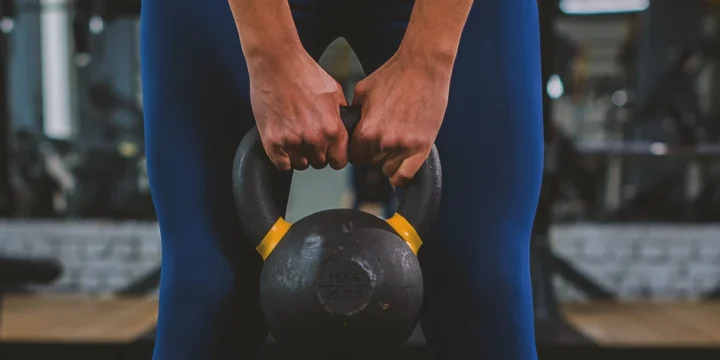The infraspinatus muscle is the most commonly injured one of the four rotator cuff muscles, with swimmers, tennis players, and weight trainers particularly vulnerable.
Shoulder injuries usually result from repetitive strain rather than sudden movements, but sudden impacts may also cause tears.
Therefore, focusing on the infraspinatus muscle is essential to prevent shoulder injuries.
Through rigorous research and observing my clients’ results, I’ve compiled a list of the best infraspinatus exercises that strengthen the muscle and improve shoulder health and mobility.
Quick Summary
- The best infraspinatus exercises include external rotations, the sleeper stretch, the pendulum, and the Y-raises.
- Working the infraspinatus helps improve posture, reduces the risk of shoulder injuries, and enhances shoulder mobility and strength.
- According to studies by the Brazilian Journal of Physical Therapy, infraspinatus side-lying wiper exercise is most effective (55.98% ± 18.79%) compared to other workouts targeting it.
- In my professional opinion, integrating these infraspinatus exercises into your routine is a game-changer for anyone looking to achieve peak shoulder health and performance.
Best Infraspinatus Exercises For Stable Shoulders
Before getting into our list, let’s quickly look at what the infraspinatus muscle is.
What Is the Infraspinatus Muscle?
The infraspinatus muscle is a triangular-shaped muscle located in the shoulder responsible for external rotation and shoulder stability.
It is one of the four rotator cuff muscles that extends from the shoulder blade to the upper arm bone.
6 Best Infraspinatus Exercises

In my experience working with weight trainees, I've noticed a significant improvement in shoulder stability when they focus on the infraspinatus muscle activity.
Incorporating exercises that target the infraspinatus along with other muscles can be beneficial for shoulder health and sports rehabilitation.
Here’s a list of the best infraspinatus exercises to strengthen your shoulder girdle and prevent shoulder injuries.
1. Side-Lying External Rotation
According to research by the Journal of Athletic Training, the side-lying shoulder external rotation produces the highest EMG activity in the muscle out of all the best infraspinatus exercises [1].
To perform a side-lying external rotation:
- Lie on your side and place a pillow under your head to support your neck.
- Bend your arm at a 90-degree angle and hold the weight in your hand, or do other shoulder isolation exercises.
- Slowly rotate your arm while keeping your elbow still.
- Continue rotating until your hand is raised towards the sky.
2. 90-90 Band External Rotation
Doing this band shoulder exercise at a 90-degree angle improves glenohumeral joint mechanics and strengthens the muscles for everyday functional movement in that position, and prevents rotator cuff injuries.
Standing external rotation is considered one of the best infraspinatus exercises to strengthen the rotator cuffs and reduce shoulder injuries, making it a valuable exercise for upper arm and shoulder health. It is commonly prescribed in physical therapy for targeting the infraspinatus muscle.
To perform it:
- Secure a band around a nearby pole.
- Lift your arm to a 90-degree angle.
- Hold your elbow in one position and pull the band backward.
- Rotate your arm while keeping your elbow stationary.
- Engage the rotator cuff by keeping your shoulder blades retracted.
3. Pendulum
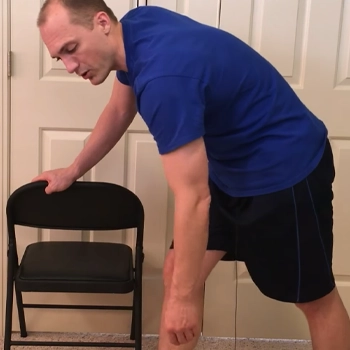
This exercise aids in preventing frozen shoulder and other shoulder injuries by stretching your muscles and the surrounding space they pass through.
Follow these steps to perform it:
- Find a sturdy object to lean on, such as a table, barre bar, chair, or barbell rack.
- Lean on it and bend forward so that your left arm hangs freely.
- Swing your arm forward and backward for 5–10 seconds.
- Swing your arms side to side for another 5–10 seconds.
- Finish by swinging your arm in a circular motion for another 5–10 seconds.
4. Sleeper Stretch
The sleeper stretch is among the best infraspinatus exercises for enhancing the shoulder joint’s range of motion and internal rotation.
It specifically targets the infraspinatus and teres minor, which forms part of the rotator cuff muscles.
To perform it:
- Lie on your right side with a pillow under your head on a firm surface.
- Place your right shoulder and elbow firmly on the bed or floor before you, with your elbow bent at a 90-degree angle.
- Use your left hand to push your right hand down towards the bed or floor, applying pressure to your upper forearm.
- Hold for 30 seconds, feeling the tension in the back of your shoulder.
- Relax for 30 seconds and repeat.
5. Side-Lying Wiper
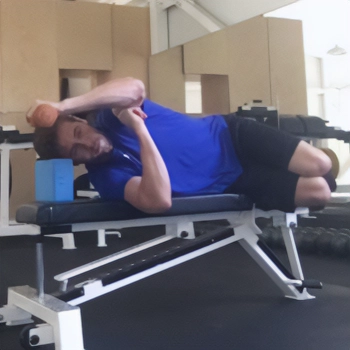
The side-lying wiper is among the best infraspinatus exercises for improving shoulder mobility and flexibility.
It involves controlled rotation of the arm and shoulder, targeting the rotator cuff and posterior deltoid muscles.
Follow these steps to do it with perfect form:
- Lie on your right side with your knees bent and your hand supporting your head.
- Hold a light dumbbell in your left hand and place your elbow against your side.
- Use your forearm and shoulder muscles to lift the weight until it's above your left side.
- Lower the weight slowly, rest briefly and repeat for 10–15 reps.
6. Y-Raise
Y-raises can be done using resistance machines, free weights, or no resistance.
They train the rotator cuff, serratus, and scapular muscles while preventing shoulder injuries.
To perform them:
- Stand upright and hold the resistance source in both hands or fists.
- Raise the arms upwards with a neutral bend at the elbows and wrists.
- The torso will form a “Y” shape at the top.
- Slowly lower your arms to the starting position.
Benefits of Working This Muscle

In my practice, I've seen firsthand how working the infraspinatus muscles with rotator cuff exercises significantly improves shoulder girdle stability.
It also prevents shoulder injuries like dislocation or subluxation while increasing the joint’s mobility.
“The rotator cuff does more than create internal and external rotation. It stabilizes the shoulder in a variety of positions.”
- Joseph Chaitkin, Movement Coach
According to studies by the Brazilian Journal of Physical Therapy, infraspinatus strengthening exercises improve sports performance that involves overhead movements like throwing, swimming, or weightlifting [2].
The best infraspinatus exercises prevent common shoulder injuries such as rotator cuff tears, impingement syndrome, and tendinitis.
Additionally, a diet rich in proteins, vitamins, and minerals can significantly enhance muscle recovery and growth, thereby preventing injuries like dislocation or subluxation while increasing the joint’s mobility.
Related Articles:
- Best Exercises for Front Delt Front
- Best Back and Shoulders Workouts
- Best Shoulder Exercises Using Barbell
- Best Prison Workouts
Safety Precautions
When performing exercises for your rotator cuffs, it’s essential to take the following safety precautions:
- I cannot stress enough the importance of a thorough warm-up before starting infraspinatus exercises. Warming up before any exercise can reduce the risk of pain and training-related injuries.
- Maintain proper form and avoid overworking the infraspinatus to prevent unnecessary stress on the shoulders and other upper body muscles.
- If you have a history of rotator cuff injury or other shoulder injuries, consult a fitness professional or a doctor before starting any new exercise program.
FAQs
What Activity Uses the Infraspinatus?
Everyday shoulder activities, external rotation, and stabilization of the shoulder joints use the infraspinatus. The four rotator cuff muscles, i.e., supraspinatus muscles, teres minor muscles, and subscapularis muscles, complement each other in shoulder movements.
How Do You Isolate Infraspinatus?
You isolate the infraspinatus by performing external rotation exercises, such as side-lying, 90-90 band, standing external rotation, and cable face pulls.
Do Face Pulls Work Infraspinatus?
Yes, face pulls work the infraspinatus muscle. It also works the rotator cuff muscles and muscles in the upper back.
How Do You Passively Stretch the Infraspinatus?
To passively stretch the infraspinatus, lie on your side, place the arm behind your back, and gently press down on the elbow with your other hand until you feel a comfortable stretch.
Reduce Shoulder Injuries With Infraspinatus Exercises
The infraspinatus muscle is one of the four rotator cuff muscles and is crucial for shoulder stability, making it important to strengthen through specific infraspinatus exercises to prevent shoulder injuries.
Incorporating the best infraspinatus exercises into your upper body workout routine can prevent shoulder injuries and maintain rotator cuff mobility, especially if you lift heavy objects during your daily work or resistance training.
Proper supplementation is crucial for building shoulder strength, in addition to regular exercise.
I highly recommend using a high-quality protein powder to fuel your muscles effectively.
Browse the list of the products we tested to find the one that works best with your workout patterns.
References:
- https://www.ncbi.nlm.nih.gov/pmc/articles/PMC3655748/
- https://www.ncbi.nlm.nih.gov/pmc/articles/PMC4647145/
About The Author
You May Also Like
